Numark Industries DXM 06 User Manual
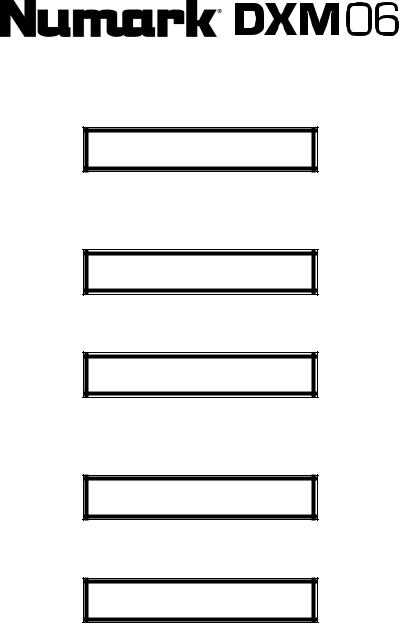
PROFESSIONAL DJ MIXER
Quick Start Owner’s Manual
BOX CONTENTS
∙MIXER
∙POWER SUPPLY
Manual de inicio rápido para el usuario
(ESPAÑOL)
CONTENIDOS DE LA CAJA
∙MEZCLADOR
∙FUENTE DE ALIMENTACIÓN
Schnellbedienungsanleitung (DEUTSCH)
SCHACHTELINHALT
∙MISCHPULT
∙STROMKABEL
Manuel d’utilisation du propriétaire
(FRANÇAIS)
CONTENU DE LA BOÎTE
∙MIXER
∙BLOC D’ALIMENTATION
Manuale rapido di utilizzazione (ITALIANO)
CONTENUTO DELLA CONFEZIONE
∙MIXER
∙CAVI DI ALIMENTAZIONE
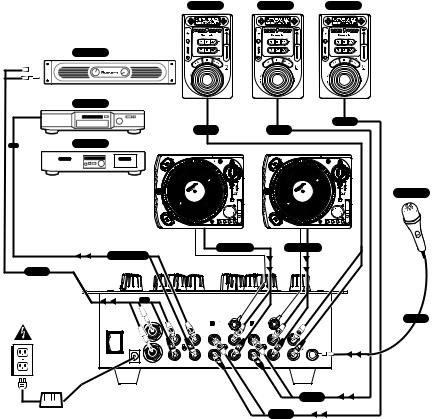
CD PLAYER |
CD PLAYER |
CD PLAYER |
HOUSE AMP |
|
|
CD BURNER |
|
|
|
|
TO LINE |
TO LINE |
TO LINE |
|
OR |
|
TAPE DECK |
||
|
|
|
|
|
|
|
|
|
|
TO PHONO 2 |
TO PHONO 1 |
FROM RECORD
TO AMP
OR
DJ MIC
TO MIC
TO LINE
TO LINE
MIXER QUICK SETUP GUIDE (ENGLISH)
1.Make sure all items listed on the front of this guide are included in the box.
2.READ SAFETY INSTRUCTION BOOKLET BEFORE USING THE PRODUCT
3.Study this setup diagram.
4.Place mixer in an appropriate position for operation.
5.Make sure all devices are turned off and all faders are at “zero”
6.Connect all stereo input sources as indicated in the diagram.
7.Connect the stereo outputs to the power amplifier(s), tape decks, and/or audio sources.
8.Plug your mixer and other devices into AC power.
9.Switch everything on in the following order.
∙audio input sources (i.e. turntables or CD players)
∙your mixer
∙last, any amplifiers
10.When turning off, always reverse this operation by,
∙turning off amplifiers
∙your mixer
∙last, any input devices
11.Go to http://www.numark.com for product registration.
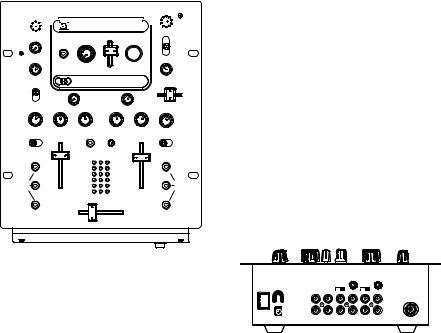
FRONT PANEL FEATURES
3



 19
19
|
22 |
25 |
26 |
27 |
|
4 |
23 |
|
15 |
||
|
|
|
|||
|
|
|
|
||
2 |
24 |
|
|
|
11 |
|
|
|
|
|
13 |
1 |
|
|
|
|
|
|
|
5 |
|
5 |
|
8 |
7 |
6 |
8 |
7 |
6 |
9 |
|
17 |
18 |
|
9 |
|
10 |
|
|
10 |
|
21 |
|
20 |
20 |
|
21 |
|
|
|
14 |
|
|
|
|
|
16 |
|
|
|
|
|
|
|
12 |
1.Mic /Aux Button: Activates Mic /Aux inputs.
2.Mic /Aux Gain: Adjusts the volume of the microphone and AUX inputs.
3.Mic Treble: Adjusts the high-tone of the microphone.
4.Mic Bass: Adjusts the low-tone of the microphone.
5.Channel Gain: Adjusts the pre-fader input level.
6.Channel Treble: Adjusts the high-tone level.
7.Channel Middle: Adjusts the middle-tone level.
8.Channel Bass: Adjusts the low-tone level.
9.Input Selector: Selects what input source is routed to the channel from the rear panel connected units.
10.Channel Fader: Adjusts the level sent to program mix.
11.Headphone Volume: Adjusts the volume level of the headphone output.
12.Headphone Jack: Your headphones can be connected to this ¼” terminal. The volume should always be set at its lowest setting while connecting and disconnecting headphones to prevent damage to headphones and/or your hearing.
13.Cue Slider: Channels 1 and 2 can be previewed using this mini-crossfader. Sliding this to the left plays the left “channel-1” and sliding to the right plays the right “channel-2”.
14.Cue Meter: Audio level display of the cue output. Depending on the Cue Selector switch, this could be Master, CH1-CH2 mini cue-fader mix, or FX. When in CH-1-CH-2 this meter shows the peak, “PFL”, Pre Fader levels of channels 1 and 2. You can use the channel “Gain” and “EQ” controls to match the levels of input signals while cueing.
15.Cue Selector: The cue selector has 3 modes:
a.Master: The Master Output is routed to the headphones.
b.FX: The FX block output is routed to the headphones. This allows you to cue the FX before applying it.
c.CH1-CH2: Allows cueing of CH1-CH2 using the mini cue-fader
16.Replaceable Crossfader: Blends audio between the channels assigned to the left and right assign switches.
Note: This fader is user replaceable if it should ever wear out. Simply remove the facepanel and then remove the screws holding it in position. Replace the fader with a quality authorized replacement from your local Numark retailer.
17.Crossfader Direction Button: Activation of this switch reverses the assignment of CH-1 and CH-2 on the crossfader.
18.Crossfader Slope Control: The position of this knob determines how quickly or intensely the crossfader will blend.
19.Master Output Knob: Adjusts the main output volume.
20.Master Meter: Shows audio level of the master output.
21.KILL Switches: Eliminate High, Mid, or Low frequencies for a unique effect.
22.Effects Assign: Selects channel to be processed.
23.Effects Process: activates the processor.
24.Effect Select: Sets desired effect.
25.Rate/Frequency: Adjust the Rate/ Frequency of the effect. Depending on the selected effect, this can be a continuous control or synchronized to the beat.
26.Effect Mix: Adjusts amount of effect to be blended with the original sound.
27.Beat Tap: Tap this button to the tempo (or half the tempo) to align effects to the music. Press and hold the button to disable beat synch control.
REAR PANEL FEATURES
|
|
3 |
4 |
3 |
4 |
9 |
|
|
|
||
|
|
|
|
|
|
|
|
|
|
|
1 |
8 |
|
|
|
|
|
7 |
6 |
5 |
2 |
5 |
2 |
Note: It is recommended that the mixer be turned off before connecting and disconnecting any sources to the inputs of the mixer.
1.Microphone Input: Microphones with a ¼” connector can be connected to this input terminal.
2.Phono Inputs: This input is used for connecting your turntables through the sensitive RIAA phono preamplifiers. Only turntables with phono level output should be attached. Line level turntables and other devices may be attached if the Phono/Line rear panel switch is set to the line position.
3.Phono/Line Source Switch: This switch activates and deactivates the sensitive RIAA phono preamplifiers. Only turntables with phono level output should be assigned when the switch is in the phono position. Some turntables offer line level output. To use these turntables and other line devices like CD players, switch the input to Line.
4.GND: This screw connector should be used to secure any turntables or other devices connected to the mixer that need to be grounded.
5.Line Inputs: CD players, Tape Decks, Samplers or other line level input devices should be connected to these inputs.
6.Record Output: This RCA output is for connecting a recording device such as a tape deck or CD recorder. The level of the record output is based upon premaster levels.
7.Master Output (RCA): This output is for connecting an external monitoring device such as a PA system, powered monitors or a home stereo. The level of the master stereo output signal is controlled by the master fader.
8.AC In: This mixer is designed to work with the power supply assembly that comes with the unit. While the power is switched off, plug the power supply into the mixer first, then plug it into the outlet.
9.Power Switch: Use this switch to turn on the mixer after all input devices are already connected to prevent damage to your equipment. Turn the mixer on before you turn on amplifiers and turn of amplifiers before you turn off the mixer.
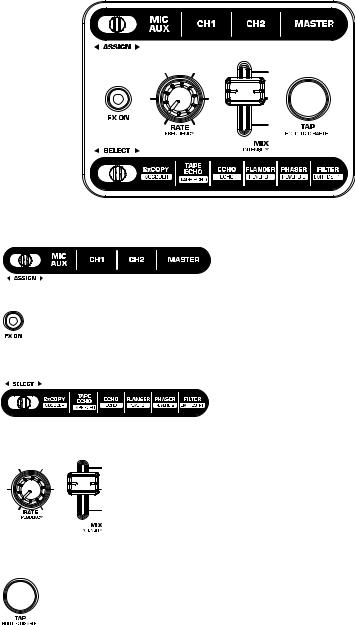
DXM06 Effects section
FX Assign: Move the toggle to select the channel you would like to process.
FX ON: Activates and deactivates the effects
FX Select: The effects can be applied to MIC/AUX, CH1, CH2, or MASTER. When FX Assign is set to MIC/AUX, you can select from the 6 FX written in small text along the bottom row (Vocoder,
Tape echo, Echo, Reverb 1, Reverb 2, LMT+DSTR). When set to CH1, CH2 or MASTER, you can select
from the 6 FX written in the in large text along the top row (2XCopy, Tape Echo, Echo, Flanger, Phaser, Filter).
FX Parameters: These controls vary by effect. WARNING Adjust slowly while learning these effects.
These effects are dangerously fun to play with. When you’re playing alone, go
nuts. When you play live, remember that your crowd sometimes just wants to hear the song. Be subtle!
BEAT SYNC/TAP ASSIST: In order to align the effects with the beat, tap the beat sync to the rhythm 3- 4 times on the beat. If it has trouble syncing, try again. The beat sync often works best when tapping to half the tempo. For example, try tapping on just the snare drums (typically the “2” and “4” count). If the beat tap loses sync slightly, don’t worry about tapping it in again, the FX will likely still maintain sync. Otherwise, you can tap on beat once to re-sync.
When in beat sync, effects below denoted with an asterisk (*) will have rates or times which are related to the tempo. Use the RATE/FREQUENCY knob to adjust the multiple of the tempo (1x,2x,4x, etc.).
To disable beat sync and have continuous control over the rate/time of an effect, simply press and hold the beat sync button until it remains lit. Now the RATE/FREQUENCY knob will allow you to precisely tune a rate or frequency. To re-enable beat sync, tap out the beat again.
Channel FX:
2XCOPY*: A copy of the signal is delayed by a defined time. The WET/DRY fader will act like a sharp contour crossfader, fading between the original (MIX/INTENSITY fader down) and the delayed (MIX/INTENSITY fader up). Pro DJs will often keep 2 copies of a record so they can do beat juggling tricks like this. Try using this effect with the beat tap sync and move the MIX/INTENSITY fader up and down to the tempo. Now try it with different multiples of the tempo using the RATE knob. You’re having fun, we know… when you’re done annoying everyone, read on. There’s more!
TAPE ECHO*: A much sought after echo sound developed in the 1960s. No reggae, jungle, house, techno, hip hop or soul DJ should be without one. In beat synch mode, the RATE/FREQUENCY controls the tempo multiple. When beat synch is disabled, the RATE/FREQUENCY will continuously control the delay time. The MIX/INTENSITY fader controls the input into the echo. This makes it very useful for selecting a phrase, vocal word or beat to echo. Simply turn up the mix momentarily during the snippet of music you wish to emphasize and bring it back down. You’ll notice how the audio which was playing during that time will now echo away. Now, try turning up the MIX/INTENSITY fader for a measure, then cutting out the music with the phono/line switch. Let it echo for a bit, then bring down the MIX fader and cut the music back in… Congratulations! you are now a remix artist. WARNING! This tape echo, like its inspirations, will saturate and have high feedback gain when the MIX/INTENSITY fader is set high. By carefully riding the MIX/INTENSITY fader you can synthesize sounds; the trick is to tame them.
ECHO*: Regular echo effect. The configuration of this echo is a little different. This time, the MIX/INTENSITY fader controls the output of echo. When the fader is up, it will echo. Push the fader further, and it will feedback heavily_ just like the tape echo. When the fader is at the bottom, the echo effect is cut out completely. This effect is very useful for juggling beats and emphasizing musical phrases.
FLANGER*: Sweeping flanger effect. In beat synch mode, the RATE/FREQUENCY controls the sweep rate as a multiple of the tempo. When beat synch is disabled, the RATE/FREQUENCY will continuously control the sweep rate. The MIX/INTENSITY controls the intensity of the flange effect.
PHASER*: Sweeping phase shifter effect. It is similar to the flanger effect, except that a flanger has a more pronounced harmonic sound, reminiscent of a jet engine passing overhead. A phase shifter is enharmonic, and has a more “swooshing” sound. In beat synch mode, the RATE/FREQUENCY controls the sweep rate as a multiple of the tempo. When beat synch is disabled, the RATE/FREQUENCY will continuously control the sweep rate. The MIX/INTENSITY controls the intensity of the phase shifter effect.
FILTER: 4-pole Low Pass Filter. The RATE/FREQUENCY controls the corner frequency of the low pass filter. The MIX/INTENSITY controls the resonance (Q) of the low pass filter. At high resonance settings, the filter will “whistle”.
MIC FX:
VOCODER: Square Wave Vocoder with Sibilance. Robot voice sound straight from the early days of electronic music. RATE/FREQUENCY controls the pitch of the vocoder. MIX/INTENSITY mixes between your voice and the vocoder sound.
TAPE ECHO*: See description in section, “Channel FX”.
ECHO*: See description in section “Channel FX”.
REVERB 1: Hall Reverberation Simulator. RATE/FREQUENCY controls the decay (size of the room), MIX/INTENSITY controls the wet/dry mix of the reverb effect.
REVERB 2: Reverse Reverb. A very eerie sound. RATE/FREQUENCY controls the delay time, MIX/INTENSITY controls the wet/dry mix of the reverb effect.
LMT+DISTORT: Band limited Distortion. Shout out “Rock the house!” or “REWIND!!!” with this effect. They’ll definitely get the point! RATE/FREQUENCY controls the distortion amount, MIX/INTENSITY controls the wet/dry mix of the distortion effect.
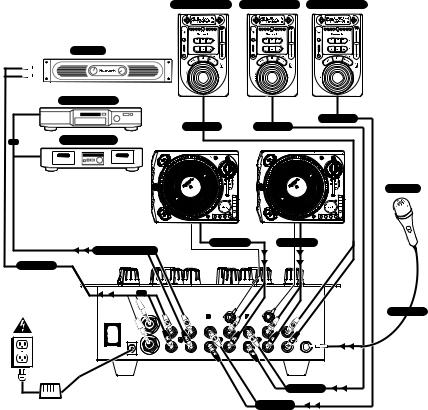
REPRODUCTOR DE CD |
REPRODUCTOR DE CD |
REPRODUCTOR DE CD |
||||||||||||||||||||||||||||||
|
|
|
|
|
|
|
|
|
|
|
|
|
|
|
|
|
|
|
|
|
|
|
|
|
|
|
|
|
|
|
|
|
|
|
|
|
|
|
|
|
|
|
|
|
|
|
|
|
|
|
|
|
|
|
|
|
|
|
|
|
|
|
|
|
|
|
|
|
|
|
|
|
|
|
|
|
|
|
|
|
|
|
|
|
|
|
|
|
|
|
|
|
|
|
|
|
|
|
|
|
|
|
|
|
|
|
|
|
|
|
|
|
|
|
|
|
|
|
|
|
|
|
|
|
|
|
|
|
|
|
|
|
|
|
|
|
|
|
|
|
|
|
|
|
|
|
|
|
|
|
|
|
|
|
|
|
|
|
|
|
|
|
|
|
AMP LOCAL
GRABADORA DE CD
HACIA LINEA
HACIA LINEA |
HACIA LINEA |
O |
CINTA DE CASSETTE |
MICRO DE DJ
HACIA PHONO |
HACIA PHONO |
DESDE LA GRABADORA
A AMPERIOS
HACIA MICRO
HACIA LINEA
HACIA LINEA
MANUAL DE INICIO RÁPIDO PARA EL MEZCLADOR (ESPAÑOL)
1.Asegúrese de que todos los artículos incluidos al inicio de este manual están incluidos en la caja.
2.LEA LAS INSTRUCCIONES DEL FOLLETO DE SEGURIDAD ANTES DE UTILIZAR EL PRODUCTO.
3.Estudie este diagrama de instalación.
4.Coloque el mezclador en una posición adecuada para su funcionamiento.
5.Asegúrese de que todos los dispositivos están apagados y de que todos los faders están en “cero”.
6.Conecte todas las fuentes de entrada al estéreo como se indica en el diagrama.
7.Conecte las salidas del estéreo a el/los amplificador/es de alimentación, unidades de cinta magnética y/o fuentes de audio.
8.Enchufe su mezclador y otros dispositivos a la toma de corriente alterna.
9.Prenda todo en el siguiente orden:
∙fuentes de entrada de audio (por ej. giradiscos o reproductores de CD)
∙su mezclador
∙por último, cualquier amplificador
10.Al apagar, realice siempre esta operación al contrario,
∙apague los amplificadores
∙su mezclador
∙por último, cualquier dispositivo de entrada
11.Visite http://www.numark.com para registrar el producto.
Para más información sobre este producto visítenos en http://www.numark.com
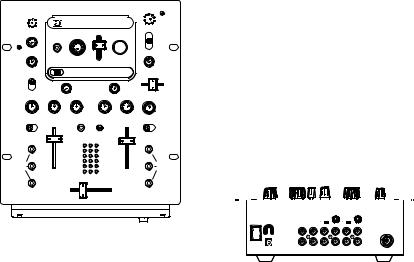
CARACTERÍSTICAS DEL PANEL FRONTAL
3



 19
19
|
22 |
25 |
26 |
27 |
|
4 |
23 |
|
|
||
|
|
|
15 |
||
|
|
|
|
||
2 |
24 |
|
|
|
11 |
|
|
|
|
|
13 |
1 |
|
|
|
|
|
|
|
5 |
|
5 |
|
8 |
7 |
6 |
8 |
7 |
6 |
9 |
|
17 |
18 |
|
9 |
|
10 |
|
|
10 |
|
21 |
|
20 |
20 |
|
21 |
|
|
|
14 |
|
|
|
|
|
16 |
|
|
|
|
|
|
|
12 |
1.Botón Mic/Aux: Activa las entradas de Mic/Aux.
2.Ganancia de Mic/Aux: Ajusta el volumen de las salidas de micrófono y AUX.
3.Agudos de micro: Ajusta el tono alto del micrófono.
4.Graves de micro: Ajusta el tono bajo del micrófono.
5.Ganancia de canal: Ajusta el nivel de entrada del pre-fader.
6.Agudos de canal: Ajusta el nivel de tono alto.
7.Medio de canal: Ajusta el nivel de tono medio.
8.Graves de canal: Ajusta el nivel de tono bajo.
9.Selector de entrada: Selecciona qué fuente de entrada es guiada al canal desde las unidades conectadas al panel trasero.
10.Fader de canal: Ajusta el nivel enviado a la mezcla del programa.
11.Volumen de los auriculares: Ajusta el nivel de volumen de la salida de los auriculares.
12.Jack de auriculares: Puede conectar sus auriculares a este terminal de ¼”. El volumen debe ser siempre regulado en su posición más baja cuando se conecten los auriculares para prevenir que se dañen los auriculares y/o su oído.
13.Deslizador de Cue: Se pueden escuchar previamente los canales 1 y 2 usando este minicrossfader. Deslizándolo hacia la izquierda suena el “canal 1” de la izquierda y deslizándolo hacia la derecha suena el “canal 2” de la derecha.
14.Medidor de Cue: Display del nivel de audio de la salida de Cue. Dependiendo del conmutador de selección de Cue, podría ser Master, mezcla mini cuefader de CAN1 y CAN2 o FX. Cuando está en los canales 1 ó 2, este medidor muestra los picos, “PFL”, niveles de Pre-Fader de los canales 1 y 2. Usted puede usar los controles de “Ganancia” y “EQ” de los canales para igualar los niveles de señales de entrada mientras avisa por medio de señales.
15.Selector Cue: El selector Cue tiene 3 modos:
a.Master: La salida Master es guiada hacia los auriculares.
b.FX: La salida de bloque FX es guiada hacia los auriculares. Esto le permite dar una señal de aviso al FX antes de aplicarlo.
c.Canales 1 y 2: Permite el dar la señal de aviso a ambos canales usando el mini cue-fader.
16.Crossfader reemplazable: Combina el audio entre
los canales asignados a los conmutadores de la izquierda y de la derecha.
Nota: El usuario puede reemplazar este fader en caso de que se desgaste. Simplemente retire el panel frontal y luego retire los tornillos que lo mantienen sujeto.
Cambie el fader por un repuesto de calidad autorizado en su vendedor de Numark más cercano.
17.Botón de dirección para el crossfader: Al activar este conmutador invierte la asignación de los canales 1 y 2 en el crossfader.
18.Control de pendiente para el crossfader: La posición de este control determina lo rápido o intenso que se mezclará el crossfader.
19.Botón de salida Master: Ajusta el volumen de la salida principal.
20.Medidor de Master: Muestra el nivel de audio de la salida de Master.
21.Conmutadores KILL: Eliminan las frecuencias altas, medias o bajas para dar un efecto único.
22.Asignación de efectos: Selecciona el canal que será procesado.
23.Procesado de efectos: Activa el procesador.
24.Selección de efecto: Configura el efecto deseado.
25.Índice/Frecuencia: Ajusta el Índice/Frecuencia del efecto. Dependiendo del efecto seleccionado, puede ser un control continuo o sincronizado del beat.
26.Mezcla de efecto: Ajusta una cantidad de efectos para que sean combinados con el sonido original.
27.Golpe del beat: Golpee este botón al tempo (o medio tempo) para alinear los efectos a la música. Pulse el botón y déjelo pulsado para desactivar el control de sincronización del beat.
CARACTERÍSTICAS DEL PANEL TRASERO
|
|
3 |
4 |
3 |
4 |
9 |
|
|
|
||
|
|
|
|
|
|
|
|
|
|
|
1 |
8 |
|
|
|
|
|
7 |
6 |
5 |
2 |
5 |
2 |
Nota: Es recomendable que se apague el mezclador antes de conectar y desconectar cualquier fuente a las entradas del mezclador.
1.Entrada de micrófono: Los micrófonos con un conector de ¼” pueden conectarse a esta terminal de entrada.
2.Entradas de phono: Esta entrada se usa para conectar sus giradiscos utilizando los preamplificadores phono RIAA. Solo los giradiscos con salida de nivel phono deben ser conectados. Los giradiscos con nivel de línea y otros dispositivos pueden ser conectados si el interruptor de phono/línea del panel trasero es ajustado a la posición de línea.
3.Interruptor de fuente phono/línea: Este interruptor activa y desactiva los pre-amplificadores phono sensitivos de RIAA. Solo los giradiscos con salida de nivel phono deberían ser asignados cuando el interruptor esté en posición phono.
Algunos giradiscos ofrecen salida de nivel de línea. Para usar estos giradiscos y otros dispositivos de línea como reproductores de CD, cambie la entrada a “línea”.
4.GND: Este conector de tornillo debería ser usado para sujetar cualquier giradiscos u otro dispositivo conectado al mezclador que debe ser conectado a tierra.
5.Entradas de línea: Los reproductores de CD, unidades de cinta magnética, samplers u otros dispositivos de entrada de nivel de línea deben ser conectados a estas entradas.
6.Salida de grabación: Esta salida RCA es para conectar un dispositivo de grabación como una unidad de cinta magnética o grabador de CD. El nivel de la salida de grabación se basa en los niveles de premaster.
7.Salida Master (RCA): Esta salida es para conectar un dispositivo de monitorización externo como un sistema de megafonía, monitores de potencia o un estéreo. El nivel de la señal de salida de la zona de estéreo está controlado por el master fader.
8.AC In: Este mezclador está diseñado para trabajar con el montaje de suministro de alimentación que acompaña a la unidad. Mientras la alimentación está apagada, enchufe el suministro de alimentación al mezclador primero y luego enchúfelo a la toma de corriente.
9.Interruptor de alimentación: Use este conmutador para prender el mezclador después de que todos los dispositivos de entrada hayan sido conectados para prevenir daño a su equipo. Prenda el mezclador antes de prender los amplificadores y apague los amplificadores antes de apagar el mezclador.
